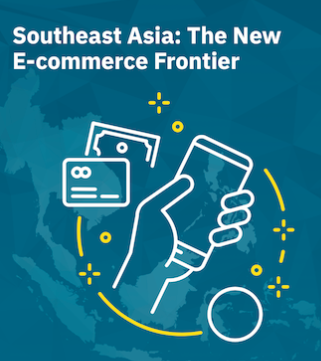By Jeff Domansky, Dec 17, 2020
Prior to the pandemic, the economies of SE Asia were booming, and e-commerce was showing substantial growth as well. A new PPRO report shows the region’s e-commerce growth even eclipses the more developed marketplaces during the COVID-19 crisis.
The Asian Development Bank forecasts the SE Asian economy will contract by just 3.8% in 2020. Compare this to other affluent markets – the OECD predicts the Eurozone will contract by 7.9% in 2020, Britain’s economy will fall by 10.1%, and the world’s economy will decrease by 4.5%. This is impressive resilience by any measure.
According to PPRO’s own research data, the region’s top-5 e-commerce markets were growing at a rate of 27.3% even before the pandemic. That’s no secret to the region’s biggest e-commerce marketplaces like Alibaba, Lazada (Singapore & region), Shopee (Singapore & region), Tokopedia (Indonesia), The Gioi Di Dong (Vietnam), citiesocial (Taiwan), and iPrice (Malaysia & region).
Let’s look at the top five economies and their e-commerce performance, digital growth, and local payment preferences in detail.
Indonesia – 3rd largest e-commerce market

At the start of 2020, Indonesia’s e-commerce market was worth $14 billion, growing at a rate of 31% annually. “Unsurprisingly, the pandemic has accelerated the growth of online shopping. 55% of Indonesian consumers say they are now buying more online than they were before the pandemic hit,” PPRO reports.
Even more impressive, the value of Indonesia’s e-commerce will reach $40 billion by the end of 2020 according to management consulting firm Redseer. That will make Indonesia the world’s third-largest e-commerce economy, surpassing India’s projected $38 billion despite having one-fifth of the population and the logistical challenge of shipping to a nation with 6,000 inhabited islands.
Online grocery shopping is predicted to grow 400% this year. 21% of Indonesians bought medicine online for the first time, followed by first-time online purchases of cosmetics (+18%), food (+17%), clothing (+17%), and electronics (+12%).
Fewer than 5% of Indonesians have a credit card, although 34% of purchases online are made with a credit card. PPRO notes, “Shoppers pay for the majority of transactions with bank-transfer apps (29%), e-wallets (17%), cash schemes (13%), and a range of minor payment methods (7%).”
Most popular local payment methods included the GoPay app, OVO e-wallet, DANA e-wallet, and DOKU (e-wallet, internet banking, bank transfers, and cash).
Malaysia – rebound ahead

While the Malaysian economy is expected to contract by 5% in 2020, it’s expected to expand by 6.5% in 2021. E-commerce grew by 149% during the first months of the pandemic. The three most popular e-commerce sites during lockdown were Shopee Malaysia, Lazada, and Food Panda.
According to research by JP Morgan, 48% of Malaysians have shopped cross-border at least once, and 40% of online purchases were made with merchants outside of Malaysia.
When it comes to online payments, 46% of Malaysians paid with a bank transfer, followed by credit cards (32%, mostly international cards), cash (11%), and e-wallet (6%). The most popular local payment methods were e-wallets Boost and GrabPay, Touch ‘n Go (e-wallet and online payment), and FPX bank transfers.
Philippines – cash still important

The number of online businesses registered in the Philippines grew by 40 times in the first six months of the pandemic, Filipino e-commerce grew 376%.
Nearly 70% of Filipinos have bought groceries online, health products (47%), and cleaning products (34%). The Asian Development Bank predicts 6.5% growth for the economy in 2021.
The most common payment for online transactions is cash (37%), using a variety of Services like Dragonpay where consumers purchase a transaction code for cash at participating stores. Other popular online payments included bank transfers (29%), cards (22%), e-wallets (8%), and other methods (5%).
Most popular forms of payment in the Philippines include Dragonpay (cash/voucher code), GCash (e-wallet), and PayMaya (mobile app).
Singapore – average order value up

The Asian Development Bank said the Singapore economy will contract 6.2% in 2020 for the first time since 2001 and will recover with growth of 4.5% in 2021. Singapore’s already popular five largest e-commerce platforms saw traffic increase by 10% during the lockdown, with average order basket value growing 51% compared with the same timeframe in 2019.
Nielsen reports 40% of Singaporeans did more of their shopping online during the pandemic, and 70% purchased grocery and household items online. 76% said they would not likely return to their pre-coronavirus shopping habits.
75% of online purchases were paid with credit or debit cards in Singapore, but there is an important distinction from other developed nations. “54% of the online purchases bought with a card were paid for using something other than Visa, Amex, or Mastercard. Usually, they were paid for using a local card of the kind non-Singaporean merchants won’t normally support.”
Other popular payment types included e-wallets (10%), bank transfers (10%), and cash (4%). Popular local payment preferences included e-wallet GrabPay, PayNow bank transfers, and hoolah, a popular buy now, pay later plan.
Vietnam – star performer

Vietnam is the star performer in the SE Asia region, with 1.8% economic growth expected during 2020 despite the pandemic. Growth in 2021 is predicted at 6.3%. The country expanded its manufacturing base, particularly with American companies, and attracted substantial investment in addition.
The average order value for online purchases grew 31% during the first six months of 2020. Online grocery shopping grew 42%, while healthcare and cosmetics increased by 31%. Even before the pandemic, e-commerce was growing at 26% annually, and the average income doubled during the past 10 years.
Local payment methods dominate Vietnamese e-commerce. According to the report, “65% of all online transactions in Vietnam are paid for using something other than a credit or debit card. And of the 35% paid for by card, 90% are bought using something other than one of the global-brand credit cards with which most people are familiar.”
Other popular payment methods included bank transfers (26%), cash (21%), e-wallets (14%), and other types (5%). With more than 3 million users, VTC Pay lets consumers pay by bank transfer, e-wallet, or international credit card. MoMo is a popular e-wallet and over-the-counter remittance and payment method used by 2.5 million Vietnamese. ZaloPay is an e-wallet built on Vietnam’s popular local messenger app.
Localization is key across SE Asia
In a world thrown into uncertainty by the global pandemic, it’s good to have some certainty. One of these is the dynamic and robust growth of the economy in Southeast Asia. By 2021, the region will grow by 5.5%. Even better, this economic buoyancy shows up clearly in the region’s e-commerce markets. According to PPRO data, the region’s top-five e-commerce markets grew at a rate of 27.3% even before the pandemic.

As PPRO notes in its report, “Any e-commerce merchant or PSP looking for the next booming online market for goods and services need to look no further than Southeast Asia. The area was already up and coming before the pandemic. But it’s a mistake to think that merchants from outside the area can simply turn up and expect to make it big in Southeast Asia. These are highly discerning shoppers with their own distinct preferences and cultural mores. Localization is key.”
You can download a free copy of PPRO’s report “Southeast Asia: The New E-commerce Frontier” here.

